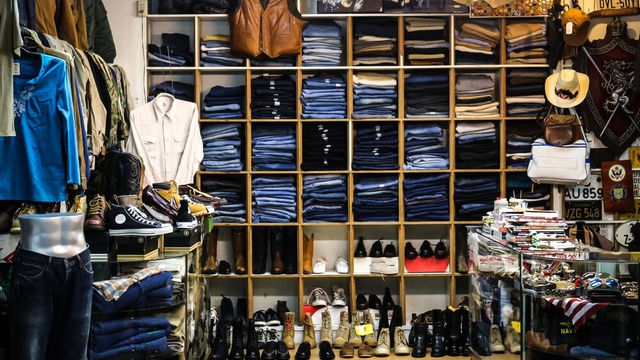Fashion is one of the biggest impactors on both the planet and the wallets of many people.
A study from 2019 showed that the fashion industry had a bigger carbon footprint than the airline and maritime industries combined.
It’s an eye-watering impact, which is why the fashion industry has made steps to become more sustainable and the backlash against constant consumerism for clothes has increased. This doesn’t just drain the planet though, it also costs more for customers, with constant clothes buying an expensive practice.
Sustainability and money-saving can go hand in hand, and with fashion that also rings true. You can still rock catwalk chic without spending unnecessarily, so we’ve rounded up five ways to reduce your fashion consumption in the future.
Stop buying fast fashion
The first thing for anyone serious about reducing their fashion consumption is to cut out fast fashion. Fast fashion is when catwalk trends are churned out at cheap rates, usually resulting in disposable clothing that is worn only a handful of times.
Although these can be cheap initially, the frequency with which they are bought means the cost soon adds up. The rapid creation and consumption result in a huge drain on the planet, not to mention ethical questions about how it was created. They can also contain synthetic fabrics, which as well as not lasting as long as other fabrics such as wool have a hefty impact on the environment.
So, it’s a good idea to eliminate it completely or at least as much as you can. But because fast fashion has become such a habitual way in which we buy clothes, it will take a degree of change. One practice that started a few years ago was the 30 wear campaign; if you don’t think you’ll wear an item 30 times, don’t buy it. You’d be surprised by how many purchases would be avoided just from this simple consideration.
If you really want to wear an item of clothing only a handful of times, consider other alternatives, two of which we’ll explain below.
Rent clothes (other people's and your own)
For a lot of people, particularly in the age of Instagram, wearing the same outfit on multiple occasions is a bit of a no-no. Which is pretty much an impossible situation if you want to meet the five wear challenge, let alone 30.
One practice that has come about to satisfy this element is renting. If you are hell-bent on wearing a costly designer outfit to a wedding, but know you can’t or are unlikely to wear it again, then this is perfect.
The likes of HURR, By Rotation and My Wardrobe all offer rental options. You can always adapt the 30 wear challenge to include renting your clothes to other people, reducing the need for the creation of new garments.
Only buy second-hand
A more drastic but rewarding action is to only buy second-hand clothes. What was once the simple act of leafing through old charity shops has since expanded, with loads of options for you to turn other people’s unwanted clobber into your personal wardrobe staples.
There are loads of online options for the thrifty fashionista. Perennial second-hand treasure trove eBay has been joined in recent years by the likes of Depop, Vinted and Manifesto, whilst even fashion outlet ASOS has its own subsite ASOS Marketplace. Oxfam themselves have a vintage site with a large inventory.
Don’t dismiss the humble charity shop either. Inner-city shops can be stocked up with an abundance of choices, with bargains to be found in smaller shops too. And vintage only clothing stores are common fixtures in a lot of high streets nowadays.
Even if you can’t completely eradicate newer clothes purchases, buying a chunk of your clothes second-hand will reduce your carbon footprint and be much kinder on your wallet.
Certain brands and clothes will retain their value as long as wear and tear doesn’t damage them too much, so selling your clothes on the aforementioned sites could make you a small profit (or at least lessen the cost of newer purchases). You can think about selling clothes you barely use; people buying them is better for the environment as well.
Upcycle your clothes via repairs and alterations
Before chucking out clothes, have you asked whether they could be repaired or recycled? So many items of clothing that exhibit the strains of wear and tear can be repaired rather than replaced, as well as being transformed into brand new garments.
Ripped jeans can easily be turned into skirts or shorts, old shirts can be freshened up with coloured buttons, and jackets turned into winter coats with sherpa linings. Repurposing old clothing provides you with the opportunity to not only save the cost on new clothes but also add individual twists for unique pieces.
You could go one step further and make your own. Knitting and crochet is one way of creating clothes that are better for the planet (and cheaper for you), and it also comes with some surprising mental health benefits.
Buy sustainable clothes
If you must buy new clothes, maybe resist the temptation to buy cheaper products and instead plump for sustainably sourced offerings instead.
Some fashion brands make sustainability a core component of the way they create clothes, including outdoor clothing company Patagonia and French trainer manufacturer Veja. Mainstream sites like ASOS help to highlight more sustainable brands in their search results too.
This may on occasion increase the cost slightly compared to less sustainable purchases, but those clothes should last longer and may have stronger resale value. Patagonia buys back old clothing, whilst denim brand Nudie knock 20% off new jeans when you part exchange your old (Nudie) pair or repair them for you for free.
You can find out more about your favourite brand, simply by Googling their name and the word 'sustainability'. If brands make it cheaper for you to be sustainable, then embrace it.
Helen is a personal finance editor who’s spent 11 years (and counting!) in the finance industry. She creates content on everything money with the goal of getting people thinking – and talking – about their finances in ways they may not have done before.
![Email icon]()
Become a money maestro!
Sign up for tips on how to improve your credit score, offers and deals to help you save money, exclusive competitions and exciting products!
Find this useful? Share it with others!









